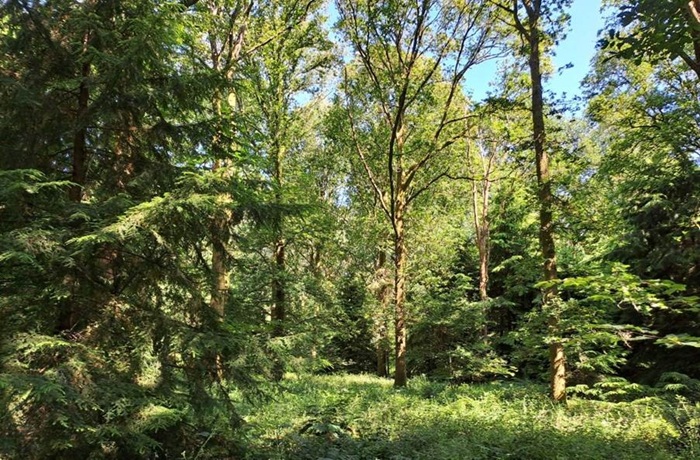22 April 2025
Tree diversity builds climate resilience and boosts economic return
Greater species diversity in productive forests can address multiple crises – from climate change and biodiversity loss to housing and domestic timber shortages – a new literature review supported by DEFRA and Teagasc suggests.
The paper published in the Quarterly Journal of Forestry calls mixed species forests an ‘insurance policy’ for UK forestry. The authors, Andrew Leslie of Forest Research and Ian Short of Teagasc, suggest that mixed species forest stands, consisting of broadleaves or broadleaves with conifers, can increase resilience to extreme weather, benefit wildlife, reduce damage from pests and diseases, increase productivity and improve the financial returns from broadleaved trees.

Mixed species forest stand at Micheldever Forest (Photo credit: Andrew Leslie)
A snapshot of the review findings:
- The review describes how different tree species respond differently to physical stresses such as storms, drought and extreme temperatures.
- The literature review also points to soil health improvements through strategic mixing. Incorporating nitrogen-fixing trees like alder, for example, can enhance overall growth, particularly in nitrogen-poor soils.
- Mixed stands aren’t just a benefit for the conservation of woods and wildlife, they also have the potential to increase yield if managed well
- The paper also discusses “overyielding,” where mixed stands produce more volume than monocultures of the same species.
- The authors describe mixed species stands as an ‘insurance policy’ against potentially devastating pest or pathogen incidents.
- The paper explains that mixing tree species may reduce the “apparency” of host trees to pests and pathogens and decrease the transfer of these damaging agents between trees of the same species.
Dr Ian Short, Silviculture Senior Research Officer with Teagasc, said: “Considering the mounting pressures on our forests from escalating pest and disease outbreaks and the accelerating impacts of climate change, the timing of this review is critical.”
“We recognised that while mixed species stands, especially those with broadleaves, constitute a significant portion of the forest area in Great Britain, there’s a noticeable scarcity of formal research specifically investigating their potential for timber production,” Dr Short added.
Co-author Andrew Leslie, Head of Silviculture and Wood Properties at Forest Research, added: “The potential for increased timber productivity in these diverse forest stands can contribute to a greater supply of domestically grown wood, potentially supporting the construction sector’s growing demand for timber.
“The increased resilience of mixed stands to climate impacts, coupled with potentially higher overall biomass production, can also play a role in climate change mitigation through carbon sequestration. Additionally, the species diversity inherent in these stands supports a more complex ecosystem, which is vital for enhancing biodiversity.”
The review concludes that while there is convincing evidence for the benefits of mixed species forest stands, more research is needed to understand the specific impacts of different species combinations.
Dr Short added: “We chose to undertake this review to consolidate the existing body of knowledge, drawing from available literature and the practical experiences of forest managers and landowners. This synthesis is vital to better understand the silviculture of these mixtures and to highlight their potential importance in a rapidly changing environment, particularly as we strive to improve the productivity of our broadleaved woodlands.
The literature review was supported by DEFRA core funding under the ‘Silvicultural Systems’ project and Teagasc under the ‘RForestS – Diversifying broadleaf stand structures to promote resilience project’.
Read the full paper in the Quarterly Journal of Forestry here (PDF).
